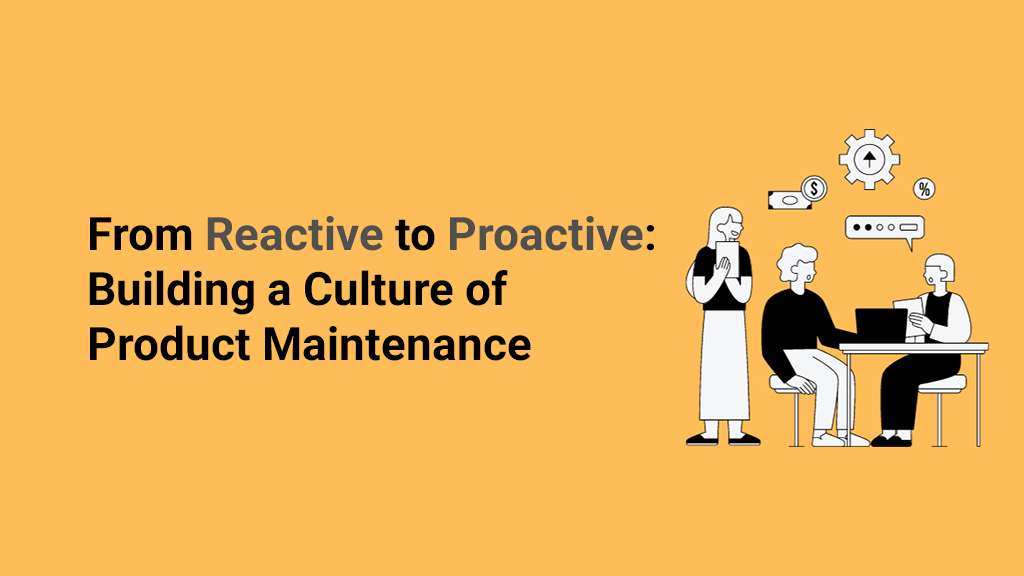From Reactive to Proactive: Building a Culture of Product Maintenance

How successful your maintenance strategy is is important for your asset management. Those companies not making efforts to create proactive maintenance plans for product maintenance will see revenue getting drained. Differentiating the maintenance strategy and taking a good reactive to proactive approach decides your company’s fate starting from operational effectiveness to bottom-line perception.
In this world of machinery, technology, and frameworks breakdowns are not avoidable and are highly disturbing and expensive. There is a huge difference between reactive and proactive product maintenance processes. Each of these approaches has a different effect on the performance of your asset.
Adoption of the right maintenance strategy and best practices offers your organization the capability to prevent downtime, lessen costly repairs, and stiffen the threat of any emergency breakdowns. In a setting, where uncertainty is consistent, creating an efficient maintenance strategy is an important factor for nourishing success and functional continuity.
Reactive vs proactive maintenance
Selecting between reactive and proactive maintenance approaches can show the difference between control and turmoil. Both of these approaches are on two different ends of the spectrum when the matter is about impact and timing. Before knowing about the difference between the two approaches, it’s important to know what both approaches are.
Reactive maintenance
It is a type of asset management where action is taken only after a malfunction or breakdown of the product. Reactive maintenance addresses issues that have arisen, mostly in a rushed and unintended manner. It is based on the principle of “fix on failure “and lack of forethought for anticipating issues.
Reactive maintenance makes businesses depend on taking immediate action after a product breakdown. This maintenance strategy often leads to higher downtimes, lower repair costs, and a high risk of unexpected operational disturbances. It is a less cost-efficient and effective choice for businesses looking to maintain optimal performance of assets.
Proactive maintenance
It is a preventive approach for management of an approach that aims at the prevention of any product failure. This maintenance approach needs regular inspections, prophetic analytics, and timely servicing which helps in identifying potential problems well in advance, facilitating the organization in intervening before issues escalate into major breakdowns.
This maintenance approach not only helps in curtailing downtime and decreases the cost but also increases operational effectiveness, making it a choice plan for enterprises washing to preserve consistent and cost-efficient operation.
Difference between reactive and proactive maintenance of product based on different factors
Timing
A reactive maintenance approach is taken after the product failure, which implies it is a kind of response to an issue that has already occurred. The main drawback is unexpected downtime and the high cost of repairing.
Proactive maintenance is everything about making plans well ahead of product breakdown. It functions on a fixed schedule and includes some routine checkups and prohibiting actions to stop the equipment from failing to operate before it even happens. Doing so assists in avoiding unpredicted issues and keeping things running smoothly.
Cost
Reactive maintenance might seem cheap initially but often ends up being expensive in the long run. It is so because it results in some emergency repairing, downtime costs when things do not work, and also damages to equipment that might have been prevented with regular upkeeping.
Proactive maintenance needs initial investment, but it keeps the potential to save a lot of your money in the long run. By making attempts to stop some major breakdowns, businesses can easily prevent expensive emergency repairs and downtimes.
Performance of the asset
Reactive maintenance of products results in reduced performance because of delayed repairing and unsolved problems. Neglecting immediate action can cause aggravated issues leading to less functional effectiveness and a high risk of breakdown.
Proactive maintenance makes sure that the equipment is operating at its optimum level, offering a guarantee of effectiveness and maintaining constant output through regular inspections, prohibiting actions, and addressing important issues before escalation.
Safety
With unpredictable failure of equipment, there is a high risk of product safety resulting in accidents and injuries for the worker or anyone available in the area.
With proactive maintenance, all potential hazards are identified and addressed before their escalation to some substantial risks, leading to a safe work environment for both the employees and also those who are around the machinery.
Plan and resources
Reactive maintenance includes very little planning and resources are often assigned on an ad-hoc basis whenever issues arise. This is a rushed method for addressing any kind of equipment issues. With proactive maintenance, there is a need for proper planning, careful allocation of resources, and establishment of a proper plan for preventive maintenance. It makes sure there is a systematic and planned approach for keeping all equipment in the best working condition.

Best practices for transitioning from reactive to proactive product maintenance
Adopting proactive product maintenance can bring in some major revolution in the asset management setting resulting in increased functional effectiveness and cost savings. Proactive maintenance needs proper planning and constant preventive actions. Changing from reactive to proactive maintenance involves something more than only a change in procedures. It needs a careful shift in the mindset and proper execution of inspections, the right analysis, and all kinds of prohibition actions.
Here are the steps to follow for making a switch from reactive to proactive maintenance
Carry out maintenance auditing
Developing an efficient proactive maintenance strategy needs an initial proper evaluation of existing practices and performances. This includes recognizing areas where reactive maintenance succeeds and knowing the consequences of unintended downtime and emergency fixes on the big functional landscapes and its effect on the allocation of budget. In this step, outlining key performance indicators is important. Businesses must reveal their maintenance goals, which can yield major benefits.
Prioritizing important assets
By pointing out the important assets within a business, your organization can line up proactive maintenance best practices on those assets that use the maximum effects on daily operations. This assists in increasing the functional effectiveness and lessening the disturbances.
Make use of the right technology: Making investments in technologies such as CMMS, like asset essentials can help streamline the predictive maintenance plans. Your business can avail the benefits of features that have been crafted for simplifying the proactive maintenance processes such as:
- Asset tracking
- Management of work order
- Predictive maintenance
- Scheduling of maintenance
- Mobile Accessibility
Training and engaging the maintenance team
How successful the proactive maintenance strategy will be depends on a well-informed and authorized maintenance team. An exclusive training and education program makes sure that your staff are well-acquainted with all the new processes. Building a culture of association and consistent enhancement makes sure there is smooth execution. It also strengthens the ability of the team to efficiently carry out the roles, contributing to the sustainable effectiveness and success of the business.
Review and do adjustments
When your business makes the transition from reactive to proactive maintenance, do a regular evaluation of the performances against the initial KPIs. These valuable insights help in making adjustments wherever necessary and in the optimization of the strategy.
Conclusion
The pathway from a reactive to a proactive approach is a slow process and needs strong commitment and consistent adjustments and tweaks. By executing all the steps discussed above, it becomes easy for an organization to develop a streamlined and effective maintenance strategy. Transitioning to a proactive product maintenance strategy is a game changer both for businesses and individuals as it helps in saving time, and money and also stresses and enhances dependability and effectiveness.


The Role of QA in AI-Driven Software Development: Ensuring Accuracy and Reliability
February 19, 2025 Read More
Understanding the Environmental Impact of Cloud Computing: Strategies for Sustainable IT
February 12, 2025 Read More
